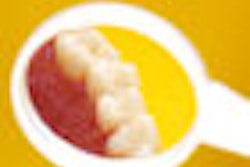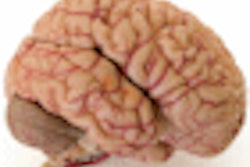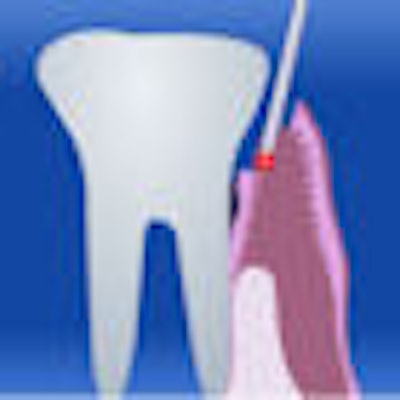
SAN FRANCISCO - The 39-year-old patient's gums looked healthy when she came for her first appointment at the office of Gregory Sawyer, D.D.S. No deep pockets, no bleeding. But instead of sending her on her way, Dr. Sawyer took a look under a microscope and found spots in her mouth that were crawling with spirochetes.
"Do you have a new boyfriend?" he asked.
"Why, yes," she answered.
It turned out that she'd been dating a man with terrible periodontal disease for the past six weeks. Dr. Sawyer was soon treating the woman to prevent periodontitis -- and began treating her boyfriend as well.
Her case illustrates the unorthodox approach that a panel of periodontal disease experts advocated during a day devoted to periodontal disease at the World Congress of Minimally Invasive Dentistry (WCMID) annual meeting. Conventional approaches to managing periodontal disease aren't working, they said, so dentists should switch to newer techniques, including lab tests, ozone, and lasers.
"I'm proposing PEMBRA," said Dr. Sawyer, a general dentist in Los Gatos, CA. "That's periodontal disease management by risk assessment."
The name plays off an approach that the same organization and others are pushing for caries -- caries management by risk assessment (CAMBRA) -- in which dental professionals screen patients for their risk of suffering damage from the disease, then apply more prophylaxis to those at greater risk. The essence, Dr. Sawyer said, "is doing something about the disease before it becomes a problem."
Borrowing a CAMBRA metaphor, Dr. Sawyer said that typical periodontal disease treatments are like repairing a flat tire without bothering to clean up the loose nails scattered in your driveway.
Beyond the bent stick
Along with educator Shirley Gutkowski, R.D.H., Dr. Sawyer disparaged the typical methods of diagnosing periodontal disease. Measuring pocket depth is unreliable because different practitioners apply different degrees of force, Gutkowski said. Even the same practitioner can push deeper depending on mood or fatigue. And, a probe might spread infection from one place to another within the patient's mouth, according to Dr. Sawyer.
In addition, he argued, pocket depth shows what has happened in the past, not what's going to happen in the future. "Can't we get beyond the bent stick?" he said.
Radiographs, too, show "historical" data. Disclosing solution and plaque index, on the other hand, only measures supragingival plaque, and can't distinguish between those that cause harm and those that don't.
As for bleeding on probing, a microscopic bur on the probe can cause bleeding. So can hypertension, menses, drugs, trauma such as from popcorn, and even the patient's unconscious expectations.
Instead, Dr. Sawyer recommends sampling the patient's sulcular fluid, looking at it under a microscope or testing the DNA of the organisms present. Dentists can buy a phase contrast video microscope for around $3,000. Or they can test samples using the Micro-IDent Plus kit by OraTec, which he said charges about $89 and takes four to 10 days to provide results.
Either way, the goal is to separate the good bugs from the bad. Good means mostly gram-positive bacteria, including Streptococcus sanguinis, S. oralis, S. mitis, Veillonella parvula, Actinomyces spp., and Rothia dentocariosa. Bad means facultatives (both gram-positive and gram-negative), anaerobes (both gram-positive and gram-negative), spirochetes, and fungi.
Gutkowski also recommends screening for such biomarkers as C-reactive proteins (CRP), calcium, glucose, oxygen saturation, and lipids. "This is within your scope," she said. "If you're afraid of it, get used to it."
These diagnostics can determine how great a risk of periodontal damage the patient faces and also a sense of the related danger of heart disease, cancer, diabetes, and other conditions related to periodontal disease.
Ozone, xylitol, iodine
If you've found signs of periodontitis risk, what should you do next? Conventional treatments don't work any better than conventional diagnostics, the panel argued. Dr. Sawyer cited a study finding that 64% of standard treatments fail (Journal of Clinical Periodontology, March 2001, Vol. 28:3 pp. 241-249).
The problem, he said, is that mechanically debriding calculus doesn't kill the pathogens, many of which can live in soft tissue.
Gutkowski recommends using ultrasonic scalers with disinfectants. "We shouldn't be using straight water," she said. "So far the only thing that keeps working is iodine." Chlorhexidine is deactivated in the presence of blood, she noted.
She also advocates the use of xylitol, which so far has mostly been used against caries. It has the ability to penetrate biofilm and even cell walls, she said.
Dr. Sawyer sometimes prescribes systemic antibiotics to kill whatever bacteria he has identified, particularly those that have spread to other parts of the body. But he doesn't see this treatment as a major line of defense against periodontal disease.
Instead he recommends a lavage with ozone -- the treatment he used with the 39-year-old apparently healthy patient. He creates his own ozone water using a medical ozonator (a swimming pool supply ozonator may work as well but costs less money, another panelist said). He backloads an Ultradent syringe to squirt the ozonated water into the sulcus.
He also uses Oxyfresh products, which combine sodium chlorite and zinc acetate to increase the oxygen saturation in periodontal pockets. "What we're trying to do is oxygenate a place where the anaerobes live to make them say, 'I'm out of here.' "
He admitted that he couldn't show research to support a lot of what he does. "It's not very scientific, but that's all I've got right now," he said.
But it's good for business. "My office is booming in the midst of the worst recession I have seen," he said. And part of the secret is convincing women that their husbands and boyfriends need treatment so the women don't get reinfected.
Laser enthusiasts
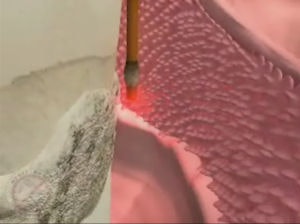 |
| In this illustration, a Millennium Dental Technologies laser debrides soft tissue inside a periodontal pocket. All images courtesy of Millennium Dental Technologies. |
The WCMID panel also said they were getting excellent periodontitis outcomes with lasers. "The results are remarkable, unbelievable," said Kim Kutsch, D.M.D.
Researchers have developed several protocols for zapping deep into periodontal pockets. Maryland general dentist Stewart Rosenberg, D.D.S., said he had gotten results comparable or better to what periodontists achieve. He said he had collaborated with Solveiga Kelbauskiene, a Lithuanian researcher, on a study in 25 patients in which Er,Cr:YSGG (erbium- and chromium-doped yttrium scandium gallium garnet) laser treatment achieved twice the pocket reduction of the conventional treatment.
His best success has come with a Waterlase (Biolase Technology) laser using an 800 micron tip at 40 Hz and 1.5 watts of output power. "The results were spectacular, and I can do a whole mouth in one hour," he said, adding that the lasers appear to kill harmful organisms and also encourage regeneration of bone and soft tissue.
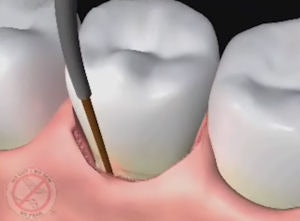 |
|
This illustration shows a Millennium Dental Technologies laser opening a periodontal pocket for treatment. |
University of Colorado periodontist Raymond Yukna, D.M.D., M.S., said that the Nd:YAG (neodymium-doped yttrium aluminum garnet) laser is the most penetrating type of laser. "I have not raised a flap for periodontal pocket disease in four years," he said, noting that Millennium Dental Technologies has patented a procedure it calls laser-assisted new attachment procedure (LANAP).
Why do the lasers seem to work so well? One explanation, offered by Utah periodontist Lloyd Tilts, D.D.S., M.S., is that 90% of periodontal pathogens are black, so they absorb more energy from lasers than other organisms do. And the beam reaches places a scaler can't. "There are many areas that we can't clean out mechanically, but light can," he said.
In addition, the laser selectively removes the epithelium in the pocket, encouraging reattachment. "The pocket is sealed with a blood clot that becomes fibrin that becomes connective tissue," Dr. Tilts said.
Dr. Rosenberg also suggested that lasers cauterize blood vessels "so you don't get histamines and there is no inflammation."
But some other as yet undiscovered effect appears to be at play as well, according to Dr. Yukna. "Some of it is black magic; it works so well, we can't explain it," he said.
Copyright © 2009 DrBicuspid.com




